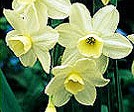 The heat in Zones 8 and warmer are difficult for spring bulbs but there are some that will do well and even return and naturalize in zones 8 and 9 without chilling. One of the most important factors when growing bulbs in hot climates is the amount of time they will have to produce and store a food supply. If the heat comes too soon after blooming, the foliage dies, food production stops, and the bulb may not have sufficient nutrients to produce flowers and leaves for the next year. Some of the most successful narcissus for climates belong to a group called tazetta narcissus. They are vigorous, freely flowering and have a musky, sweet fragrance. Each bulb bears four to eight clustered flowers on multiple stems. The flowers are dainty and with spreading perianth segments that are not reflexed. In general the members of this group are good for forcing.
The heat in Zones 8 and warmer are difficult for spring bulbs but there are some that will do well and even return and naturalize in zones 8 and 9 without chilling. One of the most important factors when growing bulbs in hot climates is the amount of time they will have to produce and store a food supply. If the heat comes too soon after blooming, the foliage dies, food production stops, and the bulb may not have sufficient nutrients to produce flowers and leaves for the next year. Some of the most successful narcissus for climates belong to a group called tazetta narcissus. They are vigorous, freely flowering and have a musky, sweet fragrance. Each bulb bears four to eight clustered flowers on multiple stems. The flowers are dainty and with spreading perianth segments that are not reflexed. In general the members of this group are good for forcing.
Here are six heirloom tazetta or hybrid-tazetta narcissus that grow well in zones 8 and 9 without chilling. The definition of “heirloom’ is fuzzy so I have chosen the date 1930 as the cut off date for heirloom because the plants have been in the trade for more than 50 years and were introduced well before plant breeding was taken over by big business. This definition should satisfy most but not all people and I have provided the date of introduction so readers can make up their own mind on the issue.
 ‘Avalance’ (aka ‘Compressus’)
‘Avalance’ (aka ‘Compressus’)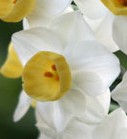 Also known as ‘Seventeen Sisters’ for its 15-20 flowers per stem, this narcissus has an informal inflorensece with flower stems of different lengths that create a pyramidal form. The 1” flowers have a creamy white perianth and bright lemon-yellow bowl-shaped cups. The foliage can be longer than the flower stems and obscure the display of flowers.
Also known as ‘Seventeen Sisters’ for its 15-20 flowers per stem, this narcissus has an informal inflorensece with flower stems of different lengths that create a pyramidal form. The 1” flowers have a creamy white perianth and bright lemon-yellow bowl-shaped cups. The foliage can be longer than the flower stems and obscure the display of flowers.
-
Date of Introduction: 1906
Size: 16-18”
Bloom Time: Early mid-spring
Hardiness: Zones 6-9
 ‘Cragford’
‘Cragford’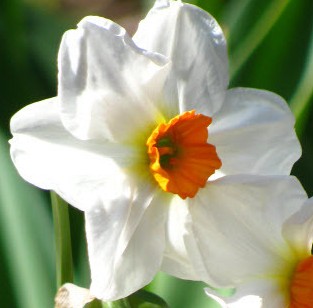 Each stem bears three to four flowers with icy white petals surround a bowl-shaped bright orange cup with a hint of green in the center.
Each stem bears three to four flowers with icy white petals surround a bowl-shaped bright orange cup with a hint of green in the center.
-
Date of Introduction: 1930
Size: 16-18”
Bloom Time: Early to mid spring
Hardiness: Zones 6-9
 ‘Grand Primo’
‘Grand Primo’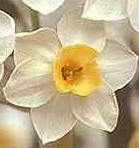 One of the oldest narcissus, ‘Grand Primo’ is common in old gardens in California, Texas, and the Gulf coast states. The flowers are borne in compact rounded clusters and have creamy white perianths and medium-sized pale lemon-yellow cups.
One of the oldest narcissus, ‘Grand Primo’ is common in old gardens in California, Texas, and the Gulf coast states. The flowers are borne in compact rounded clusters and have creamy white perianths and medium-sized pale lemon-yellow cups.
-
Date of Introduction: 1780
Size: 12-16”
Bloom Time: Early-mid spring
Hardiness: Zones 8-9
 ‘Minor Monarque’
‘Minor Monarque’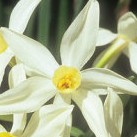 Eight to thirteen starry flowers per stem are produced in informal clusters. Each flower has a wavy cream perianth and small lemon-yellow cup. The segments of the perianth are pointed, narrow, long, and informally twisted. The foliage is dull green.
Eight to thirteen starry flowers per stem are produced in informal clusters. Each flower has a wavy cream perianth and small lemon-yellow cup. The segments of the perianth are pointed, narrow, long, and informally twisted. The foliage is dull green.
-
Date of Introduction: 1809
Size: 20”
Bloom Time: Very early spring
Hardiness: Zones 8-9
 ‘Silver Chimes’
‘Silver Chimes’ Up to eight slightly nodding flowers per stem are produced each with a silvery white perianth and pale primrose-yellow cup fading to pure white.
Up to eight slightly nodding flowers per stem are produced each with a silvery white perianth and pale primrose-yellow cup fading to pure white.
-
Date of Introduction: 1914
Size: 14-18”
Bloom Time: Mid spring
Hardiness: Zones 6-9
 ‘Scarlet Gem’
‘Scarlet Gem’ Flowers are borne 3-5 per stem and have soft yellow perianth and a red-orange cup.
Flowers are borne 3-5 per stem and have soft yellow perianth and a red-orange cup.
-
Date of Introduction: 1910
Size: 6-18”
Bloom Time: Mid spring
Hardiness: Zones 3-9
All of the narcissus mentioned above are hardy in zones 8-9 but ‘Grand Primo’ and ‘Minor monarch’ are not hardy in colder climates. These same two daffodil are more difficult to find in commerce but can be bought from on-line sources that specialize in rare bulbs such as Old House Gardens. ‘Avalanche’, ‘Cragford’, ‘Scarlet Gem’, and ‘Silver Chimes’ can be purchased from on line sources such Van Engelen Inc or Brent and Becky’s Bulbs.
